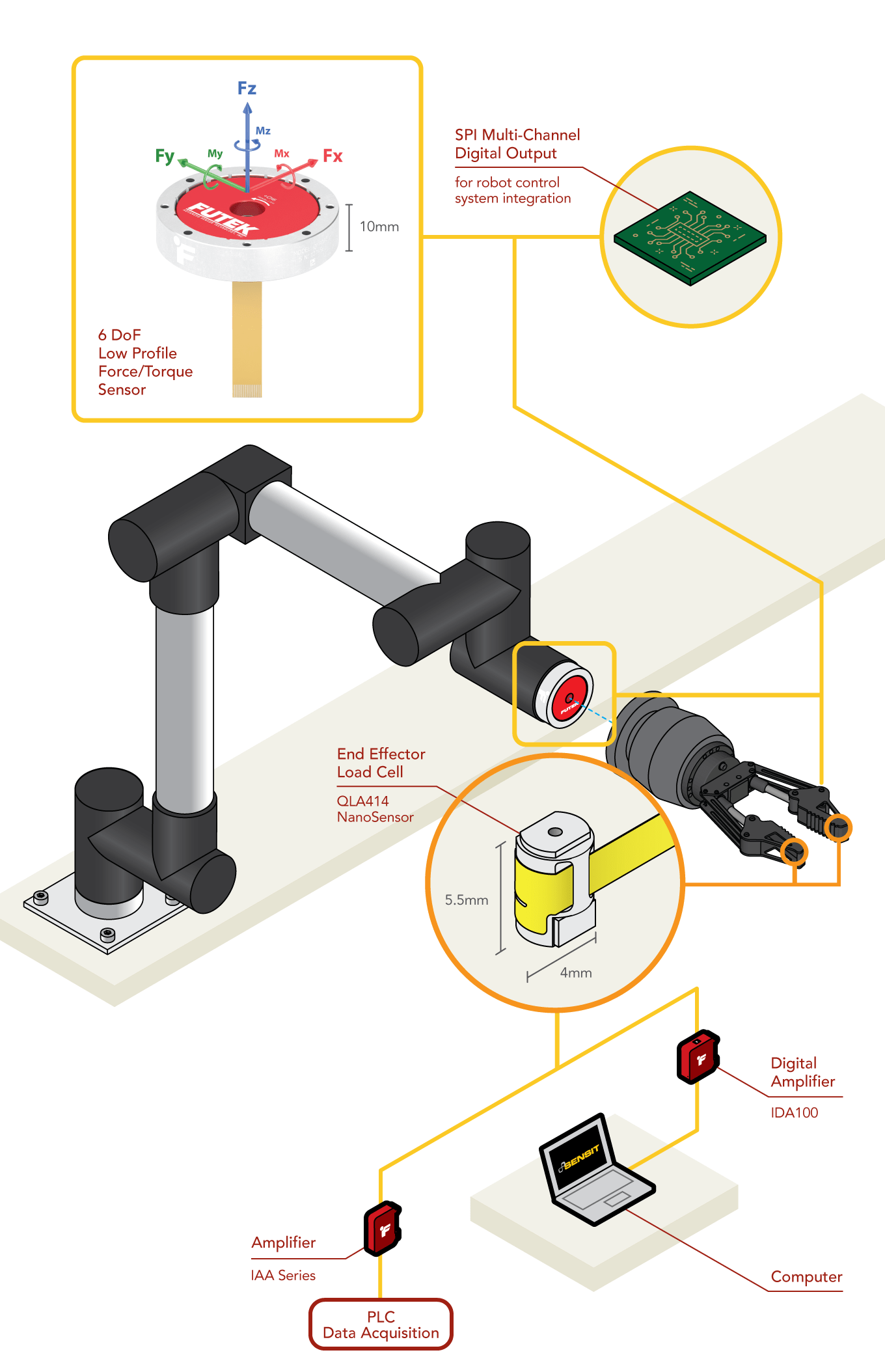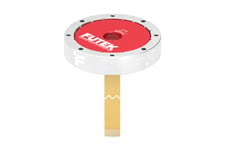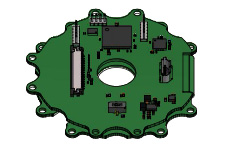Why is it important to control robot gripping force?
One of the main challenges facing the robotic industry today is that the dexterity of the fingers precludes conventional robotic systems from doing about 95% of all manual jobs.
Preparing a drink, folding a napkin, cleaning a chandelier, etc. requires extreme dexterity. Replacing these types of manual labor with robots requires accurately measuring and controlling the robot’s grasping force to increase dexterity and to make sure that fragile objects are not crushed by the gripper (i.e. semiconductor wafer handling ). Although load cells are reliable sensors for force measurement, they have historically been limited by their bulky construction.
To solve this problem, FUTEK has designed and developed a NanoSensor. Its minuscule geometry of 4 mm x 5 mm fits in the majority of the end-effector grip applications without sacrificing the reliability and precision of standard load cells. Due to its lightweight construction, it offers a high natural frequency response, making it suitable for dynamic force measurement applications.
FUTEK’s Nanosensors are customized to suit unique OEM solutions. COTS sensors are also available for proof of concept and low-volume R&D applications.
Benefits of FUTEK NanoSensor:
- ±0.5% nonlinearity of rated output (RO) in 5lb and 10lb;
- Up to 200% safe overload;
- Custom IP67 and autoclavable sensors;
- Tension and compression force sensor;
- Ultra-low deflection (0.0002” [0.005 mm]);
- High natural frequency response up to 98KHz.
- M1 threaded double-sided mounting provisions;
- 1000 Ohm full-bridge side load (off axis or extraneous loads) compensated instrumentation;
- Laser-welded construction;
What is a 6 axis force/torque sensor?
A 6 DoF sensor is a device that is used to ensure precision in robotic applications. The sensor is designed for robotic joints and it is commonly fitted onto the wrist of the robot arm to provide accurate force measurements for all three geometrical coordinates (±Fx, ±Fy, ±Fz) and the moments or torques around them (±Mx, ±My, ±Mz). A six-axis force/torque transducer is also known as a multi-axis force/torque transducer, multi-axis load cell, F/T sensor, or six-axis load cell.
Which applications require 6 axis force and torque readings?
Force/Torque sensors are used for product testing, robotic assembly, grinding, polishing, and other industrial applications in which holding a steady position and trajectory high repeatability is necessary. This sensor is particularly important in complex assembly operations where the robot will encounter different problems (misalignments, tight fits, force tests, etc) and precision motion control over the end-of-arm tooling applied force (robot end-effector) is paramount. The 6vaxis load cell allows the controller to recognize what is going on with the robot tool and improves end-effector dexterity.
In the medical device industry, six-degrees-of-freedom force/torque sensors are used in robotic surgery, laparoscopic instruments haptics, and many other applications.
Hand-guiding is an application where torque readings are necessary. As the operator guides the end-effector (robot tool) to teach it a specific path, it generates torque in the robot tool which is then read by the six-axis force/torque sensor. These multi-axis torques are then read in all the Cartesians' directions and the signal can be sent to the computer for analysis.
How it Works
The NanoSensor is mounted in the gripper of the the robot end effector. They can be fully customizable to suit unique OEM grip applications.
The NanoSensor captures the gripping forces generated by the end-effector. The sensor signal output signal is then conditioned, amplified and digitized by the USB Series , IDA100 amplifier or QIA Multi-Channel SPI Digital Output.
The instrument signal is then sent to the PLC, Desktop PC or robotic arm controller, providing high precision gripping force feedback and allowing closed control loop system.
Additionally, with the IDA100, amplified output from the sensor can be monitored and analog amplifier settings can be adjusted digitally with FUTEK's SENSIT™ Software.
Products in Use
Minuscule geometry 4 mm x 5 mm high-precision NanoSensor QLA414, paired with one of the following signal conditioners:
- QIA125 - 3 Channel Low Power SPI Digital Output;
- QIA131 - 6 Channel High Resolution SPI Digital Output;
- USB Series - Internal PCB with USB Digital Output;
- IAA Series Analog amplifiers.
Contact Us
Please Contact Us with questions.
Why is it important to control robot gripping force?
One of the main challenges facing the robotic industry today is that the dexterity of the fingers precludes conventional robotic systems from doing about 95% of all manual jobs.
Preparing a drink, folding a napkin, cleaning a chandelier, etc. requires extreme dexterity. Replacing these types of manual labor with robots requires accurately measuring and controlling the robot’s grasping force to increase dexterity and to make sure that fragile objects are not crushed by the gripper (i.e. semiconductor wafer handling ). Although load cells are reliable sensors for force measurement, they have historically been limited by their bulky construction.
To solve this problem, FUTEK has designed and developed a NanoSensor. Its minuscule geometry of 4 mm x 5 mm fits in the majority of the end-effector grip applications without sacrificing the reliability and precision of standard load cells. Due to its lightweight construction, it offers a high natural frequency response, making it suitable for dynamic force measurement applications.
FUTEK’s Nanosensors are customized to suit unique OEM solutions. COTS sensors are also available for proof of concept and low-volume R&D applications.
Benefits of FUTEK NanoSensor:
- ±0.5% nonlinearity of rated output (RO) in 5lb and 10lb;
- Up to 200% safe overload;
- Custom IP67 and autoclavable sensors;
- Tension and compression force sensor;
- Ultra-low deflection (0.0002” [0.005 mm]);
- High natural frequency response up to 98KHz.
- M1 threaded double-sided mounting provisions;
- 1000 Ohm full-bridge side load (off axis or extraneous loads) compensated instrumentation;
- Laser-welded construction;
What is a 6 axis force/torque sensor?
A 6 DoF sensor is a device that is used to ensure precision in robotic applications. The sensor is designed for robotic joints and it is commonly fitted onto the wrist of the robot arm to provide accurate force measurements for all three geometrical coordinates (±Fx, ±Fy, ±Fz) and the moments or torques around them (±Mx, ±My, ±Mz). A six-axis force/torque transducer is also known as a multi-axis force/torque transducer, multi-axis load cell, F/T sensor, or six-axis load cell.
Which applications require 6 axis force and torque readings?
Force/Torque sensors are used for product testing, robotic assembly, grinding, polishing, and other industrial applications in which holding a steady position and trajectory high repeatability is necessary. This sensor is particularly important in complex assembly operations where the robot will encounter different problems (misalignments, tight fits, force tests, etc) and precision motion control over the end-of-arm tooling applied force (robot end-effector) is paramount. The 6vaxis load cell allows the controller to recognize what is going on with the robot tool and improves end-effector dexterity.
In the medical device industry, six-degrees-of-freedom force/torque sensors are used in robotic surgery, laparoscopic instruments haptics, and many other applications.
Hand-guiding is an application where torque readings are necessary. As the operator guides the end-effector (robot tool) to teach it a specific path, it generates torque in the robot tool which is then read by the six-axis force/torque sensor. These multi-axis torques are then read in all the Cartesians' directions and the signal can be sent to the computer for analysis.





